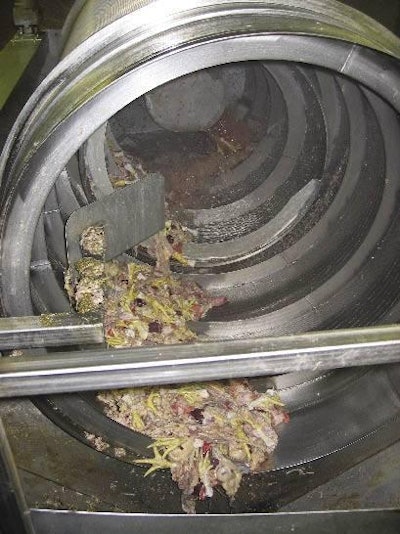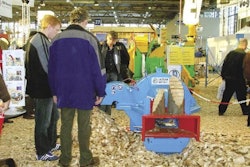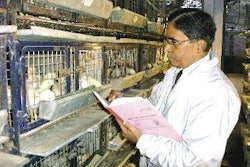
Mechanical screens of various types, designed to physically remove solids from wastewater, have seen extensive use in the US poultry industry for many years. Initially, mechanical screens were designed for the purpose of recovering poultry by-products or offal from wastewater. The recovered offal from the screens is a high-quality by-product that is valued as a raw material for the rendering industry. Over time, with the adoption of the Clean Water Act in 1972 and subsequent increases in environmental regulatory restrictions, many people in the poultry industry have begun to recognise that mechanical screens also have an important function as a preliminary step in wastewater treatment.
Types of screen
Virtually all poultry slaughter plants use some form of physical screening, making it the most commonly used wastewater treatment in the industry. Rotary screens, which are basically rotating drums, are the most common type of screen used in poultry plants and come in two major types: internal and external. With internal rotary screens, wastewater is fed inside a rotating drum. The water passes through the screened surface of the drum, while solids are retained inside where they can be conveyed to offal trucks. Of the plants reporting screen use in a 2002 US Poultry & Egg Association survey, 88% reported using internal rotary screens.
One of the most common applications of screens in poultry slaughter plants is to use multiple primary rotary screens with larger screen gap openings in series (one for feathers, one for viscera) and then combine the wastewater and pass it through a secondary rotary screen with smaller screen gap openings. Some newer double-drum screens have the primary screen inside the secondary screen, and this configuration can effectively remove large and small solids while using less space than two separate screens.
Better screening benefits by-product sales
In most applications, screens are used as a preliminary wastewater treatment process that is followed by more advanced chemical and/or biological treatment systems in order to obtain treatment levels that meet regulatory requirements. While these advanced treatment systems are effective in removing additional offal from wastewater, the condition and value of the recovered by-products change dramatically. Various chemicals (metal salts, anionic and cationic polymers) are used to enhance the removal of solids in advanced treatment systems. Although these chemicals improve solids removal efficiency, the resulting by-products are adulterated by the chemical addition. These by-products are still usable as a raw material by the rendering industry but the quality and value of the offal are greatly diminished.
The poultry industry, both in the slaughter and further processing sectors, would benefit by maximising the recovery of mechanically screened solids. By increasing the volume of unadulterated offal recovered through physical screening, the poultry processing industry would see additional revenue through increased by-product sales, and also a corresponding reduction in costs associated with the wastewater treatment and handling of adulterated solids.
What to look for in a screen
On the surface, the solution to the question of more effective physical screening seems elementary that is, to simply purchase and install screens with smaller gap openings. However, the answer is more complicated. Screening is often the simplest and least expensive form of wastewater treatment but high-quality systems require substantial capital investment. So it is vital to purchase the proper type and size of screen to remove the maximum amount of solids from a waste stream while minimising screen overloading.
Screen gap opening size and flow rate capacity are the most important criteria used to select a screen. Many other factors, however, must be evaluated. These include plant hydraulics, costs, size constraints, solids handling systems, operational requirements and engineering.
One common problem associated with screening is blinding', due either to the overloading of the screen or to under-sizing of the screen gaps. Blinding is defined as the coating over the open gap spaces of the screen surface, preventing the passage of water.
Typically in poultry plants, primary screens are perforated (circular gaps) with open spaces of 1500-3000 microns. Secondary screens are often wedge-wire, with gap openings of 500 microns although some secondary screens are effective at 250 micron openings.
Georgia team investigates micro-screens
A collaborative team at the University of Georgia made up of scientists from the Poultry Science and Biological & Agricultural Engineering departments and funded by US Poultry & Egg Association is evaluating the potential of micro-screens as tertiary screening options to enhance the removal of unadulterated offal from poultry processing wastewater.
"We have two broad overall research goals," said Dr Bill Merka, a University extension scientist and one of the project leaders. "The first is to determine the viability of using very fine screens with this type of wastewater at flows of several hundred gallons per minute without blinding. The second goal is to determine the potential economic impact on the industry if a viable micro-screening system or systems were to be developed."
Initial work by the team focused on the use of a laboratory bench-scale wet sieve apparatus to recover the particulate solids between 50 and 500 microns from three broiler plant wastewater streams. The results of the tests showed that on a dry weight basis, the recovered solids were 50-60% fat, 25-23% protein, and crude fibre and ash were each around 5%.
This initial bench-scale work was followed by a series of pilot-scale studies using an ultrasonic vibratory screen from Brandt Industries (Houston, Texas, USA) on-site in the wastewater treatment area of a Georgia broiler processing plant. Fine particulate solids were recovered using screens with gap openings of 212, 106 and 45 microns, placed after the plant's own 500-micron secondary screens. Wastewater samples were collected before and after screening, and then analysed for a number of relevant standard tests. The average concentration reductions for the samples were as follows: 13% for chemical oxygen demand; 21% for total solids; 30% for total suspended solids; 23% for total volatile solids; 8% for total Kjeldahl nitrogen; and 25% for oil and grease.
"Since unadulterated offal has a limited value of a few cents per pound," said Dr Merka, "we believe that micro-screening could increase offal revenue by a few hundred dollars per day at a slaughter plant. But we think that additional offal revenue pales in comparison to the dollar savings that will result in a reduction in chemicals and other costs associated with advanced wastewater treatment systems, not to mention reducing stress on these systems. When you start reducing chemical oxygen demand by over 10%, suspended solids by 30% and fat by 25%, that's when the daily cost savings to a plant can reach thousands of dollars."
This article was first published in Watt PoultryUSA.
















